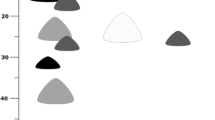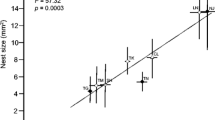Abstract
Several factors which may affect harem ownership by males ofSchizotetranychus miscanthi Saitō (a new subsocial species of theSchizotetranychus celarius complex) were experimentally tested. A marking method was developed and used for studying spider mite behavior. Nest ownership (longer male residence in a nest) had little influence on the consequence of male-male combat. Furthermore, age differences in males never affected the outcome of the combats. Length of male leg I, however, appeared to be an important factor. Factors affecting variation in male leg size were examined. Length of leg I was strongly affected by host plant quality but not by male age.
Similar content being viewed by others
References
Cone, W.W. 1985 Mating and chemical communication. In Helle W. and M.W. Sabelis (eds), Spider Mites, Their Biology, Natural Enemies and Control. Elsevier Amsterdam Vol 1A: 243–251.
Helle, W. 1967 Fertilization in the two-spotted spider mite.Ent. exp. appl. 10: 103–110.
Helle, W., W.P.J. Overmeer 1973 Variability in tetranychid mites.Ann. Rev. Entomol. 18: 97–120.
Maynard Smith, J. 1982 Evolution and the Theory of Games. Cambridge University Press, London, New York, New Rochelle, Melbourne, Sydney.
Mitchell, R. 1973 Growth and population dynamics of a spider mite (Tetranychus urticae K., Acarina: Tetranychidae).Ecology 54: 1349–1355.
Potter, D.A., D.L. Wrensch, D.E. Johnston 1976a Guarding, aggressive behaviour, and mating success in male two-spotted spider mites.Ann. Entomol. Soc. Am. 69: 707–711.
Potter, D.A., D.L. Wrensch, D.E. Johnston 1976b Aggression and mating success in male spider mites.Science, 193: 160–161.
Saitō, Y. 1986a Biparental defense in spider mite (Acari: Tetranychidae) infestingSasa bamboo.Behav. Ecol. Sociobiol. 18: 377–386.
Saitō, Y. 1986b Prey kills predator: counterattack success of a spider mite against its specific phytoseiid predator.Exp. appl. Acarol. 2: 47–62.
Saitō, Y. 1990a Two new spider mite species of the species complex ofSchizotetranychus celarius (Banks), (Acari, Tetranychidae).Appl. Ent. Zool. 25: 389–396.
Saitō, Y. 1990b ‘Harem’ and ‘non-harem’ type mating systems in two species of subsocial mites (Acari, Tetranychidae).Res. Popul. Ecol. 32: 1–16.
Thornhill, R. and J. Alcock 1983 The Evolution of Insect Mating Systems. Harvard Univ Press, Cambridge, Massachusetts, London
Yokoyama, K. 1932. New tetranychid mites attacking the mulberry leaf. Contribution I. Bionomics and external structures ofTetranychus suginamensisi. n. sp.Bull. Imp. Sericult. Exp. Sta. 8: 230–287, 2pls (in Japanese with English summary)
Author information
Authors and Affiliations
About this article
Cite this article
Saitō, Y. Factors determining harem ownership in a subsocial spider mite (Acari, Tetranychidae). J. Ethol. 8, 37–43 (1990). https://doi.org/10.1007/BF02350272
Received:
Accepted:
Issue Date:
DOI: https://doi.org/10.1007/BF02350272




